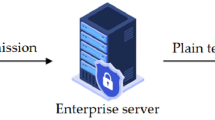
Emerging technologies such as blockchain have accelerated the digitization of a variety of industries, improved the operational efficiency of enterprises, and promoted in-depth integration of digital technology with the real economy. Blockchain has characteristics that include distributed storage, peer-to-peer transmission, strong confidentiality, and easy traceability. This article introduces blockchain into an enterprise’s information management system with the aim of breaking the enterprise’s digital barriers by using technologies such as distributed ledgers, smart contracts, and asymmetric encryption, thus improving the security and applicability of the enterprise data assets. This article explores the characteristics and security of three types of blockchain in depth, designs the model framework of the blockchain digital system (BDS) based on industry needs, and analyzes the functions and the operating mechanisms of each level of the system in detail. Finally, based on the characteristics of public blockchain, consortium blockchain, and private blockchain, three typical application scenarios in which the BDS can be used are selected, and the article discusses how E-retail supply chains, virtual power plants, and carbon trading platforms can realize digital management using the BDS, thus providing a practical basis for construction and application of the BDS.

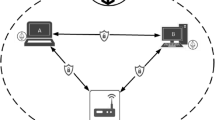
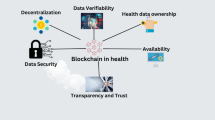
The continuous innovation provided by blockchain, the Internet of things (IoT), artificial intelligence (AI), and other digital technologies has promoted the development of Industry 4.0, and if enterprises want to improve their competitiveness continuously, they must accept and embrace the megatrend of digital transformation 1 . At the same time, the sudden outbreak of the Covid-19 pandemic has also accelerated the application of digital technology, with many industries and individual companies gradually realizing that application of digital technology such as blockchain is related not only to business operating efficiency, but also to the actual survival of these enterprises 2 . To truly realize the landing application of blockchain technology, enterprises should not stop at the marketing and management level, but should also implement the required learning and reforms related to digital technology systematically. The blockchain concept first appeared in Satoshi Nakamoto’s paper “Bitcoin: A Peer-to-Peer Electronic Cash System” in 2008, and the technology was first applied to Bitcoin and virtual currency trading systems 3 . Blockchain integrates basic technical elements such as distributed storage, peer-to-peer networks, consensus mechanisms, and smart contracts (as shown in Fig. 1) to form a new method of data recording, storage, and transmission, and solve technical problems such as decentralization, openness, transparency, and high-level autonomy 4 .
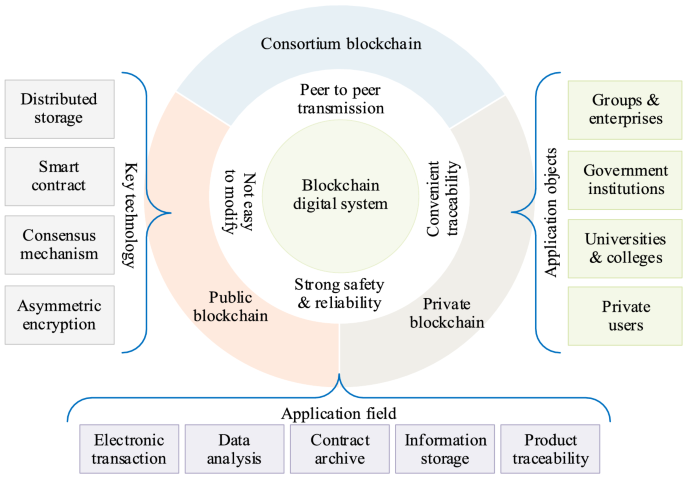
Based on an analysis of the blockchain characteristics, this article proposes that this technology can drive digital transformation of enterprises from the following perspectives. (1) Building a new digital transaction model. A blockchain can be regarded as an electronic database where each node in the blockchain network stores the complete data information in the network. This structure breaks away from the traditional centralized structure and forms a distributed storage system. The blockchain makes it difficult to tamper with the data stored in the system, ensures that the data are authentic and reliable, and then helps partners who do not know each other establish trust relationships based on these trusted data. This new trust model built using blockchain can help companies to adapt more readily to the anonymous cooperation model in the digital world, cooperate more with unfamiliar partners, and provide better services to unknown customers. (2) Strengthening the data management application capability. Each node in the blockchain stores all the data on the system, which helps companies to solve the “data silos” problem, makes each working process open and transparent, and improves collaboration efficiency. The asymmetric encryption technology that is integrated within the blockchain realizes safe sharing of information without revealing any private data. Therefore, blockchain helps enterprises to manage various process data more securely during the digital transformation process. (3) Integration of smart contracts to improve workflow efficiency. Businesses can write predetermined conditions and terms into blockchain smart contracts in the form of code. When these conditions or terms are met, the smart contract automatically begins to execute, thereby increasing the process efficiency. Based on the fact that blockchain data are difficult to modify illegally, the execution of smart contracts is also irreversible and these contracts are difficult to adjust, thus ensuring the safety and reliability of process execution.
By considering blockchain from the perspectives of classification and security as a starting point, this article performs a detailed analysis of the pain points of enterprises in terms of data value mining and use, constructs the model framework of the blockchain digital system, and demonstrates how in-depth integration of digital technology with industrial entities can be realized through blockchain. Overall, the main contributions of this study are described as follows.
As a result of the gradual upgrading of technology, massive amounts of data are generated during operation of an enterprise 5 . However, because these data commonly come from different businesses and departments, the data formats and attributes are also different, and they have complex, multi-source, and heterogeneous characteristics. When transmitting and sharing these data, so-called information island problems will then be generated 6 . As an emerging industrial technology, blockchain has characteristics that include distributed storage, peer-to-peer (P2P) transmission, and asymmetric encryption, and these characteristics are expected to alleviate these enterprise data asset management and application problems 7 . In short, blockchain, as an open information recording system, is a distributed database that is jointly maintained by its different nodes. The blockchain is composed of data blocks that are generated by cryptography; each block is stamped with a timestamp, and each has a private key generated by a hash value. Each block also contains the private key of the previous block, with the blocks being linked from the genesis block up to the current block and thus finally forming the blockchain 8 .
With the advent of the 5G era, financial technology companies were the first to discover that the distributed ledger and asymmetric encryption technologies of blockchain have strong application value for securities industries. As blockchain continues to mature, the technology is widely used in the IoT, communications, energy, medicine, and other fields. To eliminate the poor environmental adaptability of the industrial IoT (IIoT) and the problem that equipment can easily be hijacked, Feng built a consortium blockchain-based access control framework for 5G-enabled IIoT to improve device throughput 9 , and Wang proposed a novel pairing-free certificateless scheme that uses advanced blockchain technology and smart contracts to build a novel and reliable certificateless signature scheme 10 . As a technical extension of the IoT, blockchain has also promoted the development of the Internet of Vehicles (IoV). Su developed a blockchain privacy protection system for the IoV. This system designed a set of two-way authentication and key agreement algorithms using the signature algorithm, which solved the central dependence problem of the traditional IoV system 11 . Additionally, blockchain has also been applied in the electronic communications field. Khan found that by using blockchain and 6G technologies, network decentralization and resource sharing can maximize resource utilization and improve the reliability of ultra-long-distance communications 12 . To reduce the effects of proof of work (PoW) on the communication network, Li designed a blockchain-based mobile edge computing (MEC) system to solve the PoW problem 13 . In the energy field, use of the blockchain power system has been gradually promoted in energy projects. Chen upgraded the structure of a smart grid data platform with the aid of blockchain by analyzing the characteristics of the grid data 14 . In the medical field, health monitoring equipment is convenient for doctors and patients, but the open communication channels have both security and privacy risks. For this reason, Wang designed a lightweight wireless medical sensor network authentication protocol that combines blockchain technology and physically unclonable functions 15 .
In summary, this study has found that the technical application characteristics of blockchain are closely compatible with the digital strategy for enterprises. Therefore, to promote the feasibility of scientific achievement of the BDS, this research mainly supplements the existing literature from the following three perspectives: (1) analysis of the different blockchain classifications and their security in practical applications; (2) exploration of the framework model and the operating mechanism of enterprise BDS; and (3) demonstration of the applicable industry fields and scenarios for the enterprise BDS.
Essentially, blockchain refers to information processing technology that packages information that must be recorded into blocks through specific algorithm programming techniques and then uploads these blocks into distributed storage nodes, ultimately forming a chain database. This technology is characterized by decentralization and easy traceability, and it is difficult to forge. Blockchain can encrypt, transmit, and store data without reliance on any third party. Blockchain can be divided into the following three categories based on its access mechanism: public blockchain, consortium blockchain, and private blockchain 16 . A public blockchain is open to the entire network and can be accessed by any user. A consortium blockchain retains part of the centralized control function, and its data processing function and scalability are strong. A private blockchain is a private and exclusive network structure (see Table 1 for the characteristics of these three blockchain types). The different technical characteristics of blockchain make it highly suitable for use in the construction of digital management systems for various enterprises.
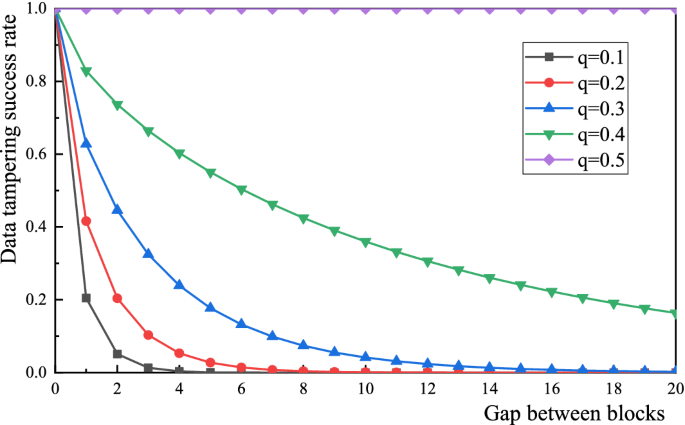
The enterprise BDS framework structure comprises a data layer, a network layer, a consensus layer, a contract layer, and an application layer (as illustrated in Fig. 3). Among these layers, the data layer, and the network layer are the basic modules and the required levels of the BDS. The consensus layer and the contract layer are the core modules and guarantee BDS operation, and the main system programming algorithms run on these layers. The application layer represents the interactive module between the BDS and the management personnel, and is the main level used to realize the enterprise digital functions.
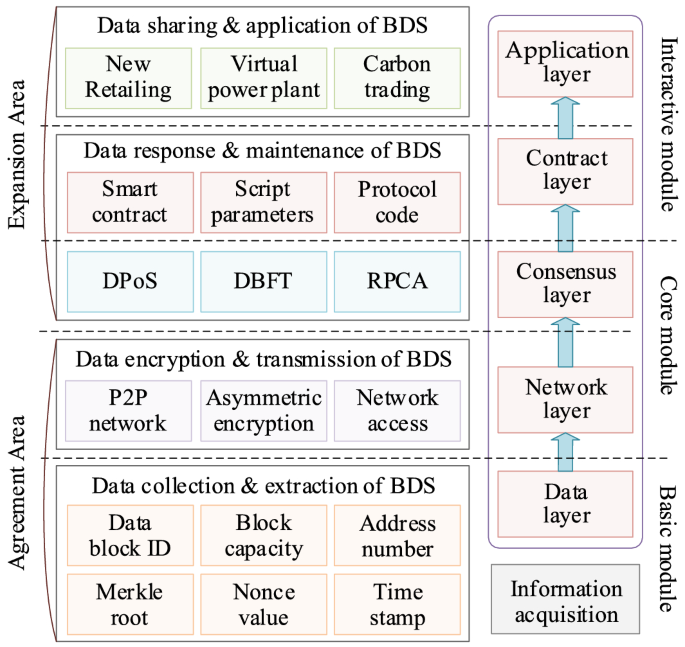
To resolve the semantic differences problem in the data characteristics, the BDS can use hybrid ontology-based information aggregation methods to clean and de-duplicate the enterprise data, slice the label data, and ultimately form a micro-ontology-based semantic structure 19 . With regard to the attribute differences issue in the data characteristics, the BDS can refer to the IEC61850 protocol to transform the text, pictures, URLs, and other information generated during enterprise operation into the more uniform formats of public information models, including the Common Information Models CIM/E, CIM/G, and CIM/XML. The block node in the data layer is composed of a block header and a block body. The block header mainly stores the block’s attribute information, including its identification number, timestamp, and Merkle root. The block body mainly stores specific data, including the data content, key instructions, the hash value, the address source, and the lock time, among other information.
Before data are transmitted on the blockchain network layer, the standardized data must be encrypted within the block and connected in sequence in a time series to ensure data security 20 . Asymmetric data encryption is divided into three main steps (the specific steps are shown in Fig. 4), as per Step 1. The Merkle tree will then authenticate and classify the data in the block nodes rapidly to ensure that the hash algorithm can perform efficient operations on the data. In step 2, after the data are authenticated, the node block uses a hash function to encrypt the data asymmetrically and generate a public key, a private key, and a ciphertext. In step 3, the ciphertext, the key instructions, the address source, and the time stamp are sealed in the block node’s hyperledger and broadcast over the entire blockchain system. At this point, an asymmetric encryption cycle of the blockchain data system is complete.
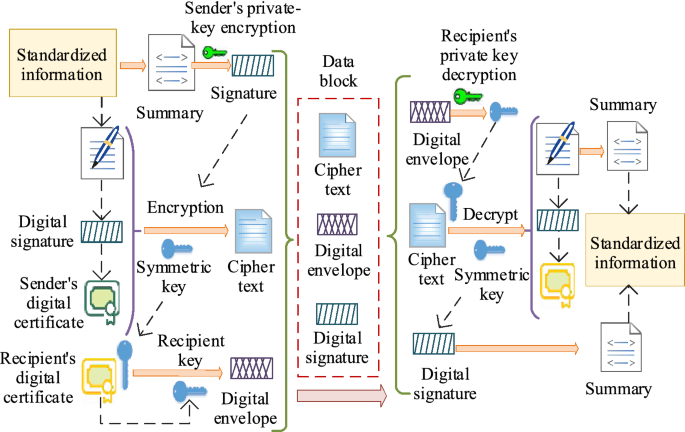
The BDS network layer contains technical elements that include the networking method for the block nodes and the data authentication protocol. The BDS network layer uses a P2P network for data transmission. In the network layer, each node not only undertakes network data transmission and block information authentication tasks, but also sets the routing protocol 21 . The data transmission process is illustrated in Fig. 5. The blockchain network layer typically has decentralization and distributed storage characteristics. The advantage of this P2P structure is that any node can authenticate, analyze, and store the enterprise data without relying on other nodes; as long as the number of failed or illegal nodes does not exceed 51% of the total number of nodes, then more than half of the computing power of the entire network will not be controlled, and the updating and extension of the main blockchain will remain unaffected.
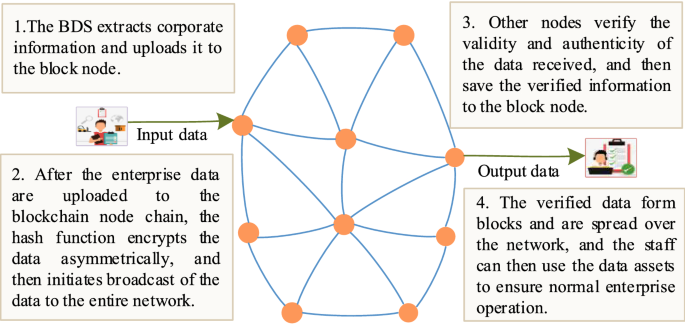
The enterprise BDS uploads various collected data to the blockchain and broadcasts these data to the entire network’s nodes through the P2P network. When the other nodes receive new block information, they first verify the authenticity and validity of the data using the data structure, the key instructions, the address source, the time stamp, and other information. If the received information passes this verification stage, the block node will then store the data in the block body in accordance with the time sequence and continue to forward the data to its neighboring nodes. If the block receives illegal data, the chain network will immediately stop dissemination of these data to ensure that the illegal data will not be forwarded on the data platform.
The consensus layer solves the information consensus and trust issues of the BDS, thus enabling some decentralized nodes to reach a consensus agreement rapidly for different data types, and also providing incentives for participants that make corresponding contributions 22 . In a highly autonomous distributed system, the combined application of multiple consensus mechanisms enables all block nodes to reach a consensus within a relatively short time. This is also the most critical factor in maintaining the fairness of the entire system and ensuring that the chain structure is not attacked using illegal data. Currently, blockchain includes seven main types of mainstream blockchain consensus algorithm (as shown in Table 2), and these different consensus mechanisms each have their own characteristics.
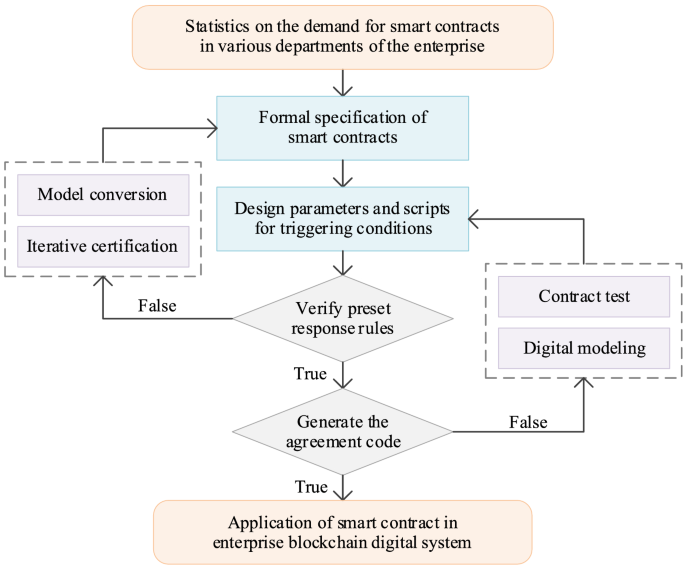
The BDS application layer encapsulates the BDS application scenarios and is also an interactive processing platform for the enterprise data. The BDS mainly analyzes and applies the enterprise’s static and dynamic data. Static data mainly include information with relatively low fluctuation frequencies, including company profiles, product information, and revenue data; dynamic data mainly include user details, contract lists, transaction information, and other information that fluctuates frequently, and the application values and application difficulty of these data will also vary proportionately. So, the BDS application layer can process distributed data in a timely manner, determine the current operating status of the enterprise rapidly, and produce a corresponding analysis report. Furthermore, all departments in the company can obtain relevant analysis reports through the block link port to complete their information interactions with the data system. In addition, the application layer can also use information feedback from the BDS to judge the requirements for enterprise improvement measures and assess the future development direction of the industry. The application layer not only provides a basic framework support for the digital system, but also provides technical services, operating models, and management strategies for the enterprise.
Fields that show strong demand for blockchain application usually involve the following distinctive features: fields in which the system’s internal communication efficiency is low, but the consensus is high; fields in which high data authenticity is required; and fields in which there is demand for high data flow efficiency and quality. Selection of the appropriate type of blockchain based on the characteristics of the different blockchain types can bring out the maximum efficiency of the BDS. Blockchain offers certain unique advantages, but it does not mean that a BDS can be applied in all industries. To achieve the perfect combination of enterprise and BDS, it is necessary to begin with the industry characteristics and match industries with similar functions to the blockchain. This study explores the characteristics and the industry applicability of blockchain from the perspectives of the three types of blockchain characteristics and selects three representative scenarios, e.g., E-retail supply chain, virtual power plants, and carbon trading platform, to analyze BDS operability fully in practical applications.
(1) Public blockchain is suitable for scenarios in which large numbers of subjects participate and do not require entry permission. Using E-retail supply chain as an example, the number of participants in the E-retail supply chain is huge, and the transaction behavior cannot be quantified regularly. Maintaining interactions with other nodes at any time will waste communication and computing resources. A BDS based on public blockchain can help participants to join the system when the transaction is in progress and then exit the system at a time when the transaction is stopped; this can record and protect the product production and transportation information effectively, and also reduces the computing costs and energy consumption of the BDS. (2) Consortium blockchain is suitable for scenarios in which a small number of participants must ensure operational efficiency. Using virtual power plant as an example, virtual power plants (VPP) are composed of various micro power generation systems and power transmission systems. A BDS based on consortium blockchain can help VPP to participate in power supply coordination management of the power market and grid operation. This can solve the problems of power shortage and low energy efficiency through off-peak power generation, and can achieve transparent and efficient energy aggregation optimization in an autonomous environment. (3) Private blockchain has become a technology that tends to be centralized and is suitable for data sharing within an organization to ensure that the data cannot be modified. Using the carbon trading platform as an example, a trading center can use a BDS based on private blockchain to audit and manage the carbon emission trading data of different enterprises across various regions. Based on the premise of ensuring that the data cannot be tampered with, this will improve the carbon trading information utilization rate and maximize the value of the data.
Based on the analysis above, industries that were relatively close to the characteristics of the three types of blockchain were selected in this study for in-depth analysis, with the aim of resolving the industry pain points with the aid of blockchain and the BDS platform.
E-retail companies are using advanced technologies such as radio-frequency identification (RFID) and the IoT to transform the production, transportation, and sales processes of agri-food and other commodities, and are reshaping their business structures and ecological chains 24 . However, E-retail companies still face specific challenges, including product anti-counterfeiting traceability, logistics information forgery, consumer information leakage, and information transmission barriers. The probability of safety problems occurring within each link has thus increased greatly, and traceability and accountability difficulties are also increasing. Determination of how to ensure traceability information authenticity is thus a major problem for the entire E-retail industry. Specifically, when product quality disputes occur, it is difficult for traditional centralized databases to provide effective traceability evidence, but a BDS based on public blockchain can use its technical advantages to resolve these difficult problems for E-retail supply chains.
The E-retail BDS process based on public blockchain operating is illustrated in Fig. 7. E-retail companies can implant RFID electronic tags at the beginning of product production, and the BDS will register the product information automatically. These products then have an electronic identity that allows the product’s full life-cycle information to be traced for anti-counterfeiting purposes. The information generated in each link throughout commodity processing, logistics, and warehousing is also recorded in the RFID tags through the BDS, which can then provide real information about each link to regulatory authorities, cooperative enterprises, and consumers 25 . Algorithm 1 demonstrates implementation of a smart contract for product registration; Algorithm 2 demonstrates the transactions updating at each step in the supply chain process.
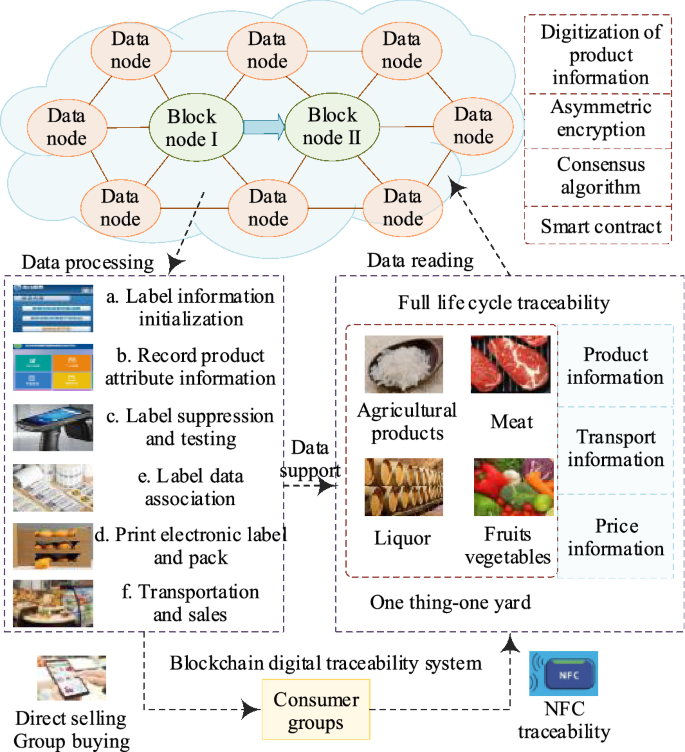
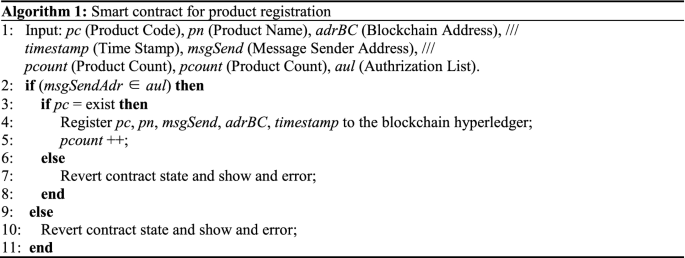
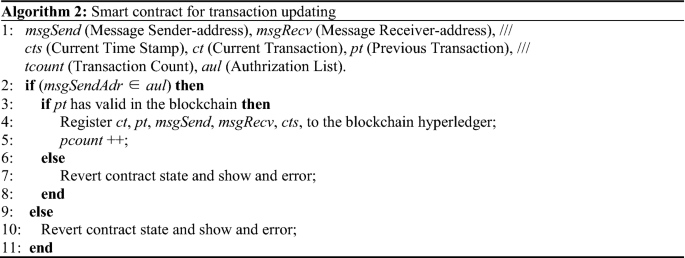
The virtual power plant (VPP) is currently the mainstream choice for use with distributed new energy power systems. The VPP is not restricted by geographical factors. Instead, the VPP uses a blockchain digital power system (BDPS) based on consortium blockchain to aggregate small and diverse distributed power sources, energy storage equipment, and the power IoT to form a special power plant and enable participation in operation of the power grid. Using the methods of peak-cutting and valley-filling, distributed energy can be transformed and consumed within the power system, thus reducing resource waste. The VPP, with the assistance of the BDPS based on consortium blockchain, uses P2P network communication technology to connect distributed power generation equipment (DPGE), combined heat and power (CHP) systems, the prosumer model (PSM), and power load platforms (PLPs) simultaneously, and can also record the real-time information and power status of the distributed power system 26 . Figure 8 illustrates the BDPS operation model based on the VPP.
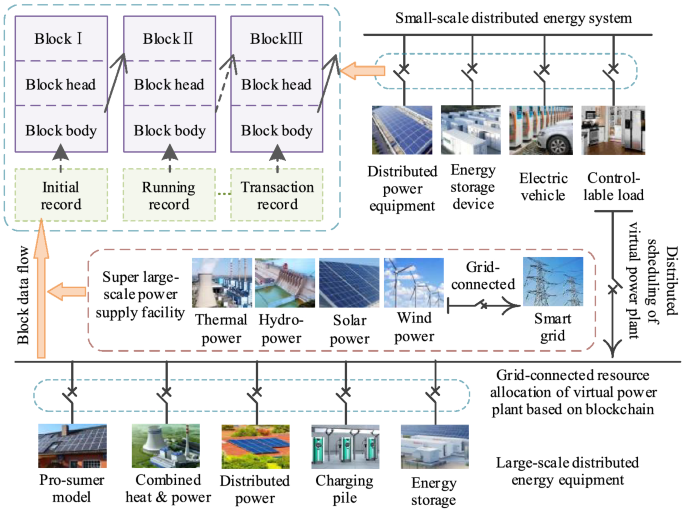
In the VPP, the number of intelligent terminals configured for distributed energy system operations on different scales is also different. A VPP with fewer smart terminals can be connected to the grid directly through smart microgrids, while a VPP with more intelligent terminals can be coordinated and controlled with the aid of the BDPS based on consortium blockchain and participate in grid connection in a unified manner. This power block will be used as a basis for resource allocation and performance incentives to encourage more distributed energy companies to participate in grid connection activities, thus creating more grid connection opportunities and improving the grid connection efficiency and stability. Algorithm 3 demonstrates the smart contract that allows prosumers to complete initialization in the VPP 27 . Algorithm 4 shows the contract process for microgrid energy settlement.
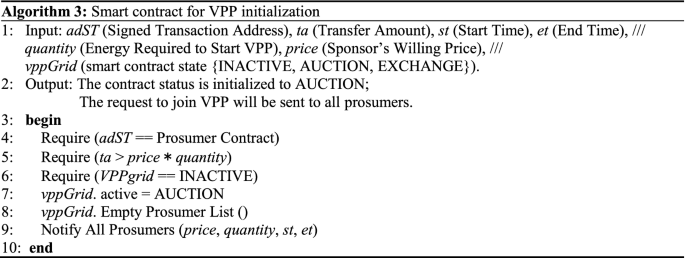
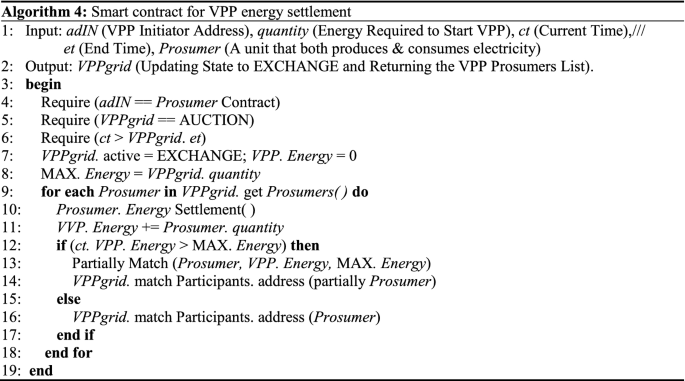
The principle of carbon trading is that the government incorporates enterprises with carbon emissions that have reached a designated scale into their carbon management system and then allocates annual carbon emission allowances to these enterprises annually. If the carbon emission allowance allocated to a company is not used up or is insufficient, the carbon trading platform then allows the company to use these carbon emission rights as a commodity in the market for trading 28 . A carbon trading platform based on private blockchain can convert carbon indicators into digital carrier values, allocate carbon emission rights in a reasonable manner, and encourage completion of carbon trading contracts. The information sharing and traceability characteristics of the BDS allow the carbon trading platform to track and record allocations of carbon allowances, thus providing a credible and reliable regulatory environment for carbon trading.
The framework for a carbon trading platform based on a BDS is shown in Fig. 9. With the support of the BDS, the carbon trading platform cannot perform excessive external interventions in the trading business, but is specifically responsible for trading security and platform maintenance. Smart contracts can record all transaction contracts and settlement lists, which are stored permanently on the server and cannot be modified at will. This not only simplifies the carbon trading platform system settings and reduces its operating costs, but also resolves the problems of low-efficiency multi-agent identity authentication and data confirmation difficulties during the trading process. Additionally, private blockchain allows the transaction parties to maintain distributed data jointly, thus increasing carbon trading transparency, stabilizing carbon market prices, and improving business processing efficiency 29 . Algorithm 5 illustrates the transaction data uploading process of the carbon trading platform. Algorithm 6 illustrates the process of querying historical logs in the carbon trading platform.
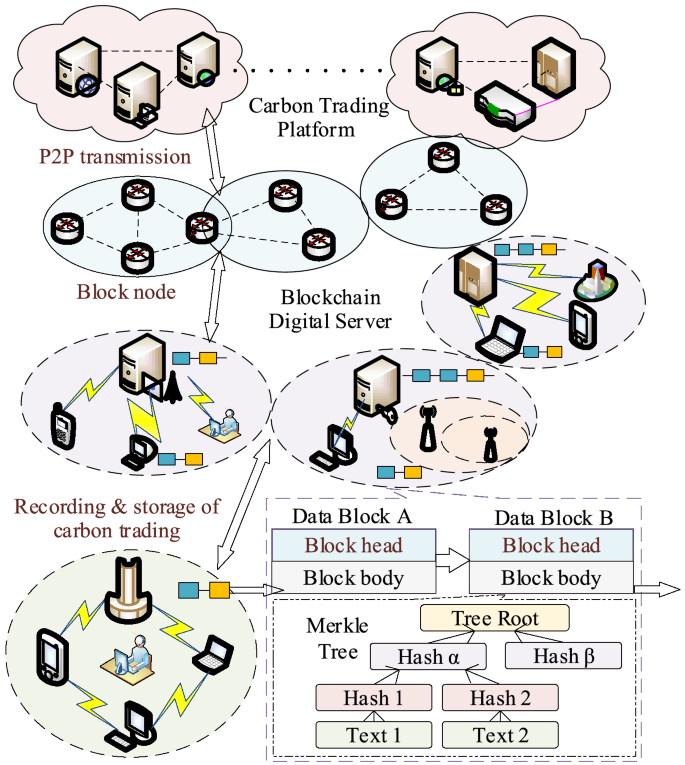
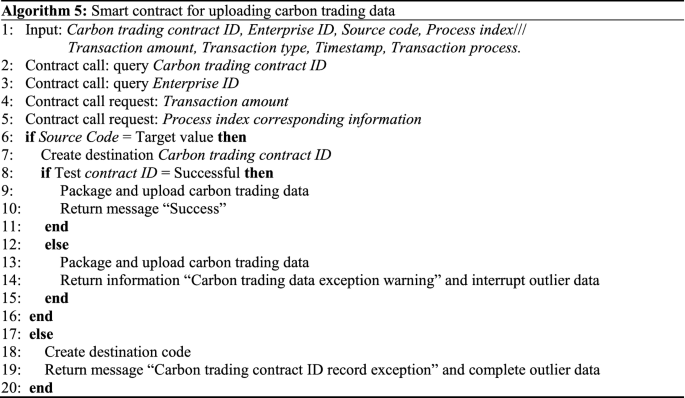
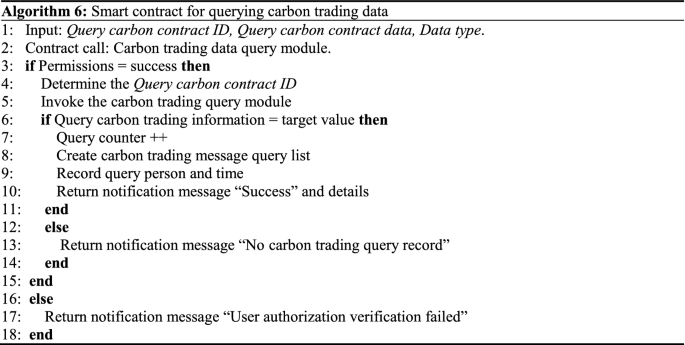
This article introduces blockchain into digital management processes with the aim of breaking down barriers in enterprise digitization processes by using advantageous technologies such as distributed storage and encrypted transmission. This article proposes a model BDS architecture and analyzes the operating mechanism on each level in detail. At the end of the study, the author discusses the potential advantages of massive data and rich application scenarios, and demonstrates how three different industry types can achieve digitization using blockchain. The introduction of blockchain into the digital transformation of enterprises is still in its initial exploration period, and a relatively uniform system standard has not been established to date in the academic field. Blockchain should not be limited to Bitcoin mining and currency speculation, but should also be used with existing technologies to solve practical problems. With continuous promotion of blockchain, its potential application scenarios will become increasingly abundant. As the basic framework for industry digitization, the BDS will inevitably attract increasing attention. This article hopes to offer beneficial results for future applications of blockchain technology (Supplementary Information).
Data sets (source code, raw data) generated and analyzed during the current study are available in the github.com repository, https://github.com/sw8258/BDSsourcecode.git and also are available from the corresponding author on reasonable request.
This research was funded by the National Social Science Fund of China (19BGL150), and Shandong Provincial Natural Science Foundation (ZR2020MG046).